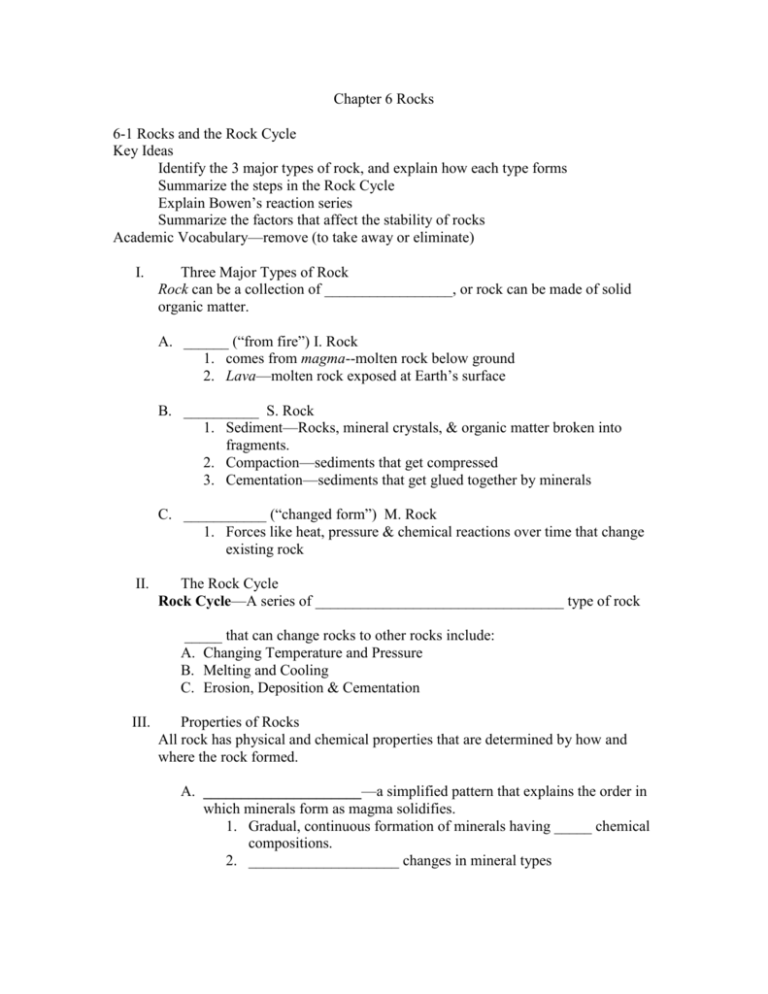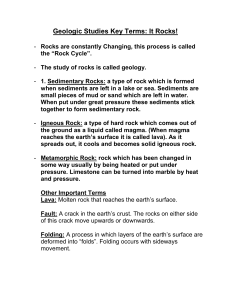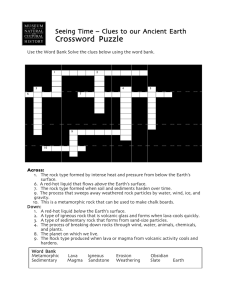Copy of Rocks Fill in Notes
advertisement

Chapter 6 Rocks 6-1 Rocks and the Rock Cycle Key Ideas Identify the 3 major types of rock, and explain how each type forms Summarize the steps in the Rock Cycle Explain Bowen’s reaction series Summarize the factors that affect the stability of rocks Academic Vocabulary—remove (to take away or eliminate) I. Three Major Types of Rock Rock can be a collection of _________________, or rock can be made of solid organic matter. A. ______ (“from fire”) I. Rock 1. comes from magma--molten rock below ground 2. Lava—molten rock exposed at Earth’s surface B. __________ S. Rock 1. Sediment—Rocks, mineral crystals, & organic matter broken into fragments. 2. Compaction—sediments that get compressed 3. Cementation—sediments that get glued together by minerals C. ___________ (“changed form”) M. Rock 1. Forces like heat, pressure & chemical reactions over time that change existing rock II. The Rock Cycle Rock Cycle—A series of _________________________________ type of rock _____ that can change rocks to other rocks include: A. Changing Temperature and Pressure B. Melting and Cooling C. Erosion, Deposition & Cementation III. Properties of Rocks All rock has physical and chemical properties that are determined by how and where the rock formed. A. _____________________—a simplified pattern that explains the order in which minerals form as magma solidifies. 1. Gradual, continuous formation of minerals having _____ chemical compositions. 2. ____________________ changes in mineral types B. Chemical Stability of Minerals—measure of the tendency of a chemical compound to __________________________________ rather than break down to form a different chemical. 1. Greatest are rocks whose minerals have the greatest number of bonds b/n _______________ C. Physical Stability of Rocks—rocks have zones of weaknesses determined by how and where they form. 1. Zones may form ____________ of S. Rocks or as _____ in I. Rock 2. Rocks _____ more easily along these zones 6-2 Igneous Rocks Key Ideas Summarize three factors that affect whether rock melts. Describe how the cooling rate of magma and lava affects the texture of Igneous Rock. Classify Igneous Rocks according to their composition and texture. Describe intrusive and extrusive Igneous Rock. Academic Vocabulary--proportion (the relation of one part to another or to the whole). I. The Formation of Magma When magma cools and hardens, it forms Igneous Rock. A. ______ Melting—when different minerals in rock melt at different Temperatures. B. Fractional Crystallization—The ______________________ of different minerals from cooling magma, as occurs in Bowen’s Reaction series. II. Textures of Igneous Rocks ________—Rocks from magma that cools deep inside Earth’s crust. ________—Rocks from lava that cools at Earth’s surface. A. Coarse-Grained Igneous Rock—I. Rock ________________________ due to having a longer time to cool. B. Fine-Grained Igneous Rock—I. Rock composed of _____ crystals due to ________ cooling time. C. Other Igneous Rock Textures 1. ___________—I. Rock that has a mixture of large & small crystals. 2. ________—Formed from quickly cooling magma 3. ________—When magma that contains a large amount of dissolved gases cools rapidly, the gases become trapped as air bubbles. III. Composition of Igneous Rocks—Mineral composition of I. Rock is determined by the chemical composition of its magma. A. Felsic Rock—from magma that has a _________________ 1. Includes Granite, Rhyolite, obsidian & pumice B. ______ Rock—from magma that contains a lower proportion of silica but is rich in Fe & Mg. 1. Includes Basalt & Gabbro C. Intermediate Rocks—contain _____ proportions of silica than Felsic but _______ proportions of silica than Mafic. 1. Includes Diorite & Andesite IV. Intrusive Igneous Rock—I. Rock that forms underground. Magma can intrude or enter other rock masses (can also be called _______). A. Batholiths & Stocks 1. ________--“deep rock”. Formations that spread over 100 square kilometers @ the surface. Ex: Coast range of British Columbia. 2. ______—cover less than 100 square kilometers @ the surface. B. Laccoliths—“lake of rock” when magma pushes the overlying rock layers into a dome Ex: ______________. C. Sills & Dikes 1. Sills—When magma ____________ & is parallel w/ rock layers. 2. Dikes—When magma __________ rock layers. V. Extrusive Igneous Rock—I Rock that forms on Earth’s surface A. _________—vent for escaping magma, gases & ash. B. Volcanic Neck—Solidified _________ of a volcano. C. Lava ______—Flat masses of rock. D. Lava Plateau—Lava Flows that ___________ w/ thick rock. E. _____—Ash & other solid particles released during volcanic eruption. 6-3 Sedimentary Rock Key Ideas Explain the processes of compaction & cementation. Describe how chemical& organic sedimentary rocks form. Describe how clastic sedimentary rock forms. Identify seven sedimentary rock features. Academic Vocabulary--transport (to carry from one place to another) I. Formation of Sedimentary Rocks Sediment-_____________ of rock, minerals & organic material that results from natural processes, including the physical breakdown of rocks. A. Compaction—Processes by which sediments are _________. B. Cementation—Processes in which sediments are _____________ by minerals deposited in water. Three main types of S. Rock—Chemical, organic & clastic II Chemical Sedimentary Rocks A. Chemical Sedimentary rock—formed when ions from dissolved minerals ____________ of water because of changing concentrations of chemicals. 1. _________—minerals left behind due to evaporation (ex: Gypsum, Halite or Rock Salt). III. Organic Sedimentary Rock A. Organic Sedimentary Rock—Rock that forms from the ______ of living things (Ex: Coal & Limestone). IV. Clastic Sedimentary Rock Forces of Wind, Water, Ice & Gravity _____________ away from their original source. A. Clastic Sedimentary Rock—S. Rock that forms when ___________ ______________ are compacted or cemented together. Classified by the ____ of the sediments they contain. 1. Large fragments—2mm to boulder size. a. Conglomerate—rounded fragments. Means they _________________ before being cemented together. b. Breccia—angular, shape corners. Means they ________________ before being cemented together. 2. Sand-sized grains a. Sandstone 3. Clay-sized particles a. Shale V. Characteristics of Clastic Sediments Forces of __________________________ carry fragments away from their original source. A. _______—the tendency for currents of air or water to separate sediments according to size. B. VI. _________—The farther sediment travels from its source, the finer & smoother the particles of sediment become. Sedimentary Rock Features The place in which sediment is deposited is called a ___________ environment (Ex: rivers, deltas, beaches & oceans). A. Stratification—________ of S. Rock. 1. ____—Stratified layers that vary in thickness 2. Massive Beds—form when sediments are deposited for ____ periods of time or when ___________ of sediment are deposited at one time. B. Cross-beds & Graded Bedding 1. Cross Beds—_______ layers 2. Graded Bedding—Different sizes & shapes of sediment settle to ____________. a. Commonly occur—larges grains on ______, smallest on ___ b. ______ Grading—smallest grains on bottom, largest on top (Ex: some mudflows). C. Ripple Marks—caused by the action of wind & water on ____. D. Mud Cracks—form when muddy deposits ___ & ______. E. Fossils & Concretions 1. Fossils—_______ or traces of ancient plants or animals. 2. _______—Form when minerals precipitate from fluids & build up around a nucleus. a. Geode—Minerals that crystallize inside _______ in S. Rock. 6-4 Metamorphic Rock Key Ideas Describe the process of metamorphism Explain the difference between regional & contact metamorphism Distinguish between foliated & nonfoliated metamorphic rocks, & give an example of each Academic Vocabulary—generate (to bring about; to produce) I. Formation of Metamorphic Rocks—Metamorphism is when heat, pressure, or chemical processes change one type of rock to another type of rock. A. _______ Metamorphism—a change in the texture, structure or chemical composition of a rock due to contact with magma. B. _______ Metamorphism-- a change in the texture, structure or chemical composition of a rock due to changes in temperature & pressure over a large area, generally as a result of tectonic forces. II. Classification of Metamorphic Rocks—metamorphic rocks are first classified by their texture. A. Foliated Rocks—Foliation is the metamorphic rock texture in which mineral grains are arranged in _____________. B. Nonfoliated Rocks—The metamorphic rock texture in which mineral grains are __________ in planes or bands.






